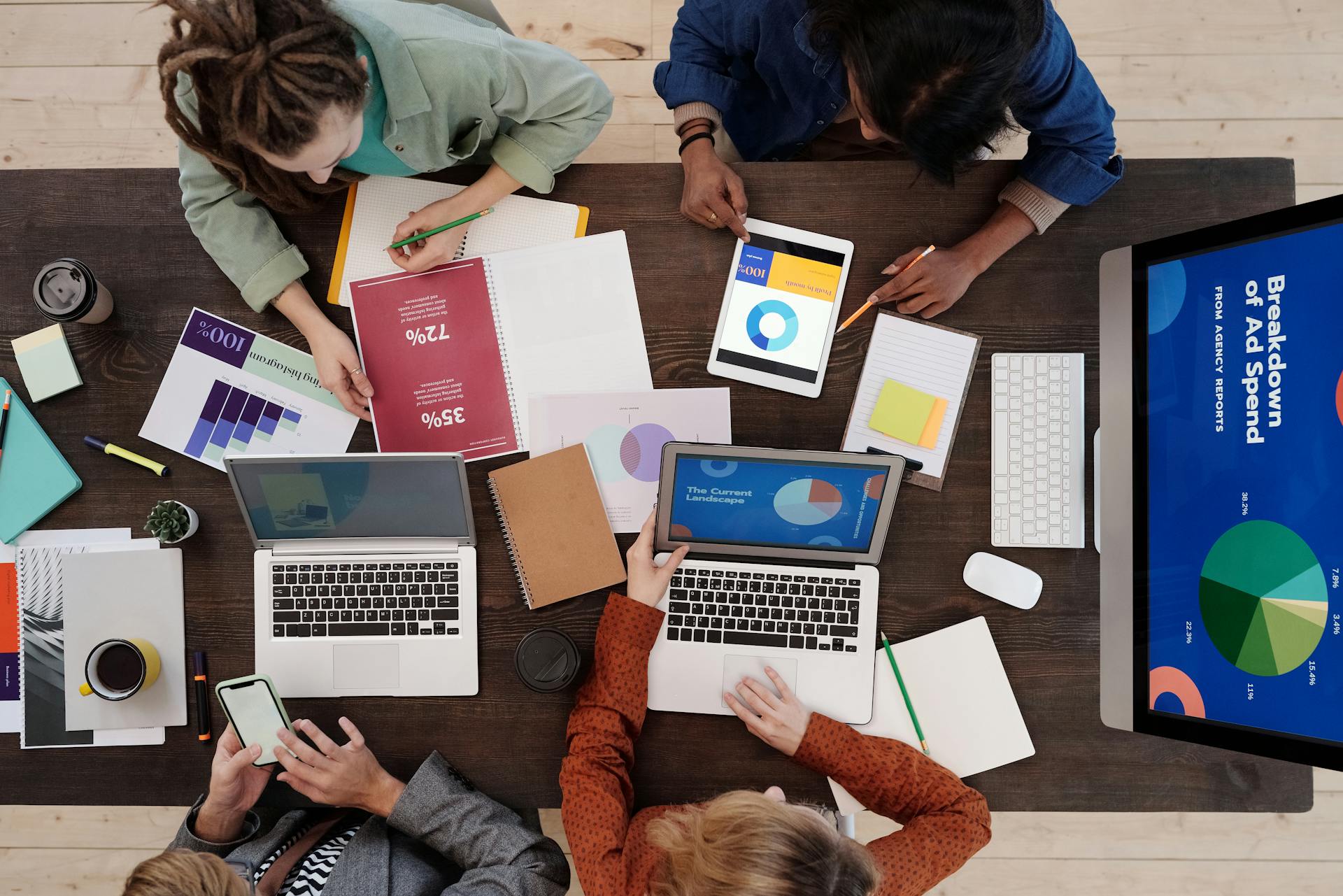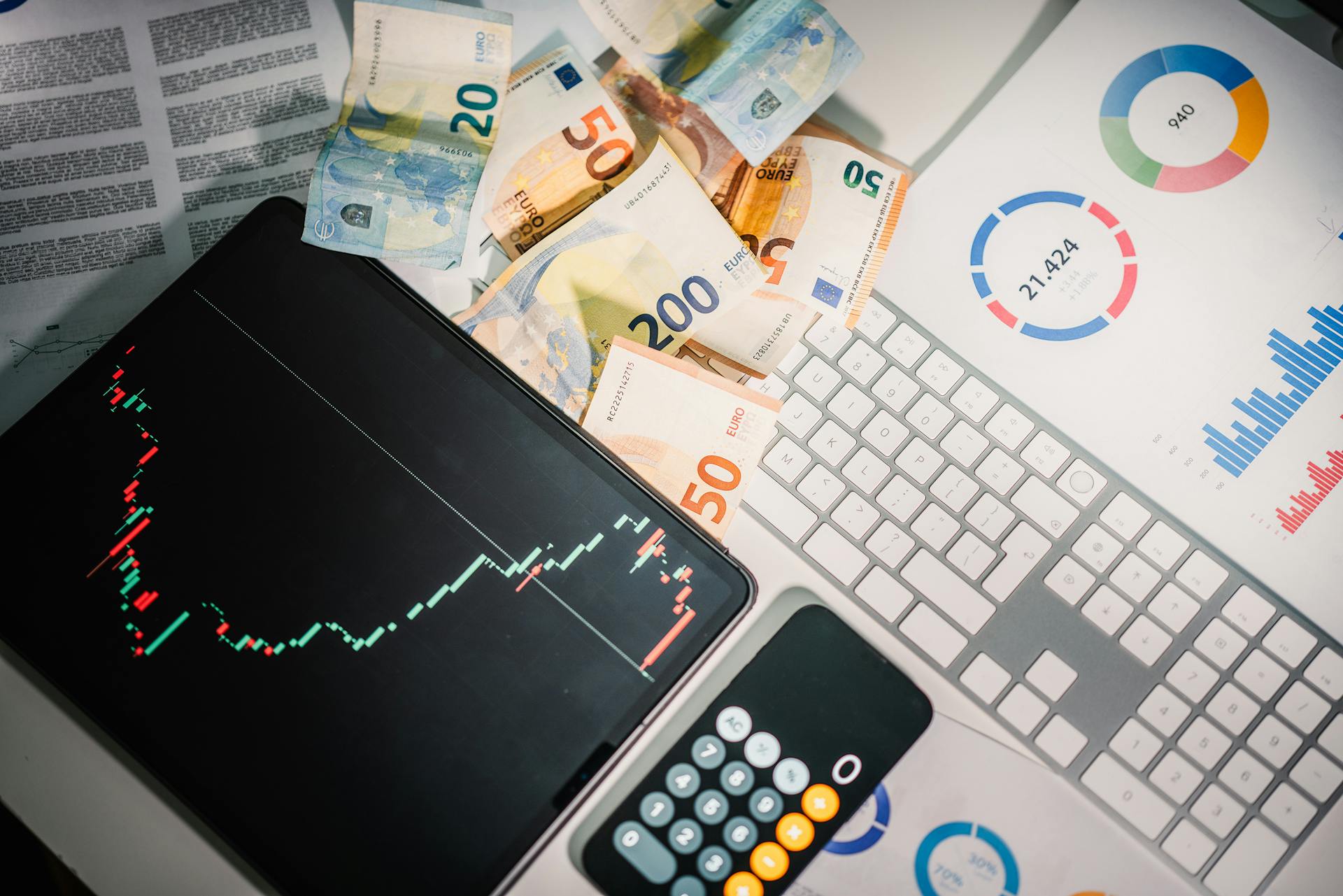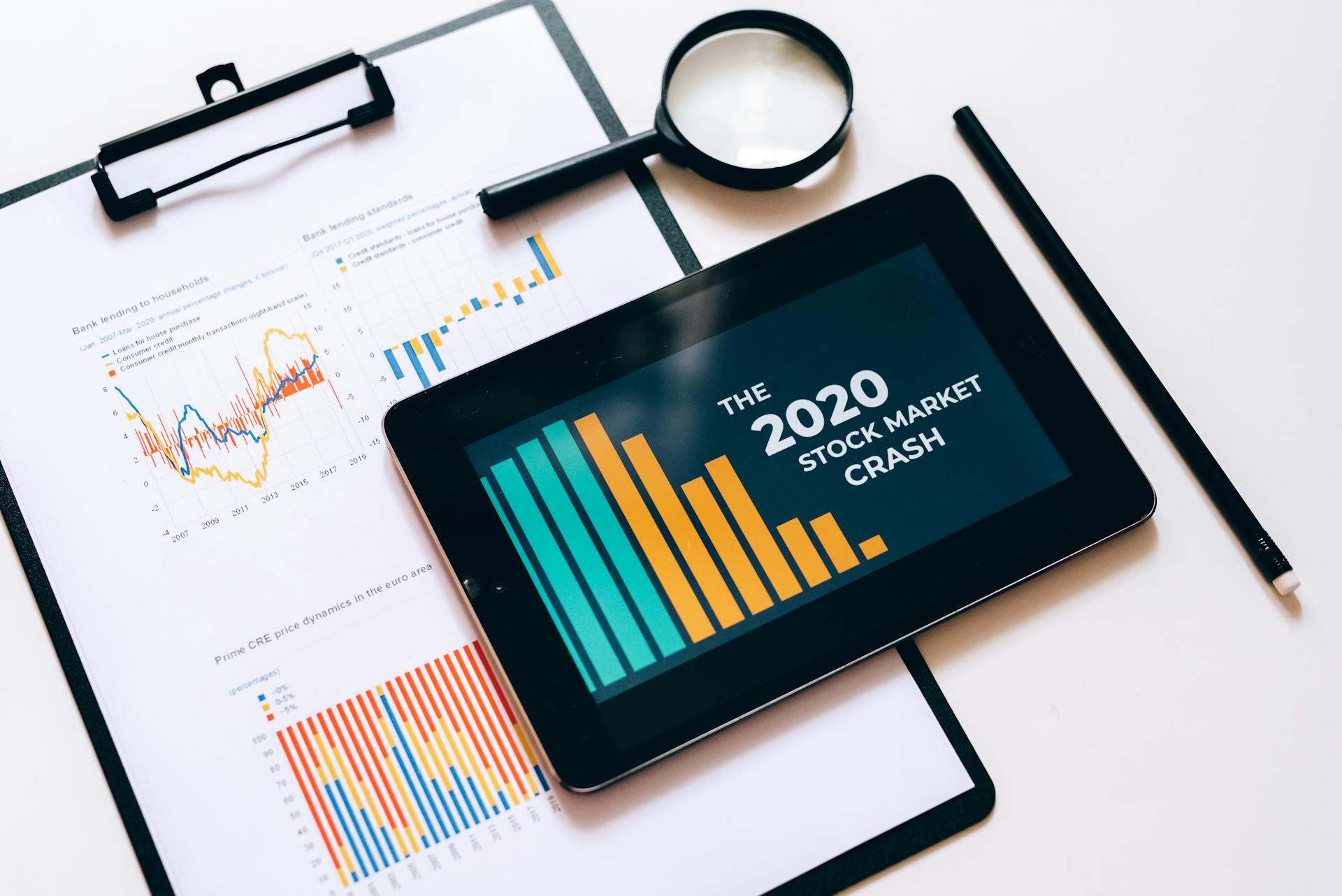
Share buybacks have been a popular tactic for companies looking to boost their stock prices and reward shareholders.
Companies like Apple and Cisco Systems have been prolific buyers of their own shares, with Apple buying back over $50 billion worth of stock in 2019 alone.
The concept of share buybacks dates back to the 1980s, when companies first started using them as a way to return cash to shareholders.
In the 1990s, share buybacks became a key strategy for technology companies, with companies like Intel and Microsoft using them to finance their growth.
Consider reading: Companies with Share Buybacks
What is a Buyback?
A stock buyback is when a company repurchases its own stock, reducing the total number of shares outstanding. This can give more value to the remaining investors.
One of the major ways a company can use its cash is by buying back its own stock. Other options include investing in its operations, paying off debt, buying another company, and paying out the money as a dividend to investors.
A company can use its excess profits or accumulated cash on its balance sheet in a few different ways, including:
- Reinvesting profits into the business by developing new products or increasing its inventory.
- Acquiring other businesses.
- Paying a dividend to shareholders.
- Buying back shares of its own stock.
The mechanics of stock buybacks are usually quite simple. A buyback program is established, and the company's board will authorize the buyback for a specific dollar amount with an expiration date. For example, a company might have a $500 million buyback authorization that begins on July 1, 2024, and ends on June 30, 2025.
Benefits of Buybacks
Companies that buy back their shares can create significant value for investors. This is especially true when done consistently over time, as it can elevate investors' returns significantly.
Buybacks can be a more tax-efficient way to return earnings to shareholders compared to dividends. Dividends are taxable to those who receive them, while buybacks don't incur the same tax burden.
By reducing the number of shares outstanding, buybacks can increase earnings per share, making each share more valuable. For example, if a company is worth $1 billion, but is split fewer ways, each share is worth more.
Worth a look: How to Calculate Interest Tax Shield
Share buybacks can be a smart way for companies to return cash to shareholders who want to exit the investment. This can be especially beneficial for shareholders who want to cash out and reinvest their money elsewhere.
Here are some key benefits of buybacks:
- Share buybacks create value for continuing shareholders if purchased for less than intrinsic value.
- Repurchases return cash to shareholders who want to exit the investment.
- Buybacks increase earnings per share by reducing the number of shares outstanding.
- They increase the stock's potential upside for shareholders who want to remain owners.
- Buybacks are a more tax-efficient way to return earnings to shareholders.
Disadvantages of a
Disadvantages of a stock buyback can be significant, and it's essential to consider them when evaluating a company's share buyback history. A poorly executed buyback can destroy value, and some critics argue that it can be used to cover up stock issuance to managers.
Buybacks can be used to obscure how much issuance affects share count, making it difficult for investors to understand the true impact on ownership. Managers may have options that become valuable once the stock price reaches a certain level, and they may influence the stock price via repurchases to secure a gain on their options.
If a management team is buying stock at any price, rather than at a good price, it may be wasting shareholder capital. For example, if a stock is only worth $100 but a management team is buying it for $150, that destroys value.
A buyback can also starve the business of money needed in other areas, such as research and development or investment into new products and facilities. This can erode the competitive position of the business and weaken it over time.
Here are some reasons why specific buybacks may be bad:
- Buybacks can be used to cover up stock issuance to managers.
- Buybacks may allow managers to enrich themselves at the expense of shareholders.
- Buybacks can be poorly executed, wasting shareholder capital.
- Buybacks can starve the business of money needed in other areas.
Investor Perspective
When evaluating a company's share buyback history, it's essential to consider the investor perspective.
A company's track record of delivering returns is crucial in determining whether a buyback is a good decision. If management has a strong track record of delivering returns, it's a good sign for the future of your investment.
Newly public thrift banks regularly repurchase stock as a way to create value for shareholders, and investors expect them to do so. The track record here is excellent, as these banks go on to be acquired at much higher prices.
To determine whether a specific buyback is a good use of investors' money, you need to dig into the company and its situation. Here are some key factors to consider:
- Why is the company conducting the repurchase?
- Is the buyback simply vacuuming up shares issued to management?
- Are the shares being repurchased at attractive prices?
- Does management have a strong track record of delivering returns?
Good for Investors?
Whether a company's stock buybacks are good for investors depends on the company's motivations and actions. A competent CEO who invests in buybacks after prioritizing operations can be a good sign for shareholders.
Companies like Apple have successfully used buybacks to boost earnings per share and drive stock prices. In Apple's case, repurchasing hundreds of billions of dollars in stock over the last decade has helped the company become one of the best long-term investments.
However, not all buybacks are created equal. If a company is repurchasing stock to simply offset dilution from stock-based compensation, it may not be a good use of investors' money. On the other hand, newly public thrift banks regularly repurchase stock to create value for shareholders, and their track record is excellent.
To determine whether a buyback is good for investors, consider the following questions:
- Why is the company conducting the repurchase?
- Is the buyback simply vacuuming up shares issued to management?
- Are the shares being repurchased at attractive prices?
- Does management have a strong track record of delivering returns?
By asking these questions and considering the company's motivations and actions, investors can make a more informed decision about whether a buyback is good for them.
Warren Buffett's Views
Warren Buffett has often spoken about the merits of share repurchases, calling their disciplined use the surest way for a company to use its cash intelligently.
He identified two key conditions for favoring a company buying back its own shares: the company must have enough money to handle operational and liquidity needs, and its shares must be selling at a significant discount to a conservative estimate of their intrinsic business value.
Buffett's views on share repurchases are not just theoretical; he's also explained how they can add or destroy value for shareholders through a simple example.
Company Buyback Strategies
Company buyback strategies can be a powerful tool for companies to create value for their shareholders. Companies can buy back shares if they have excess cash and want to return it to investors, giving them extra cash to invest elsewhere.
A company can buy back shares if it thinks its stock is undervalued, allowing them to get good value for their money. By doing so, they can increase the stock's potential upside for remaining shareholders.
Consider reading: What Penny Shares to Buy
Companies can also use buybacks to balance out the dilution of shares caused by employee stock options. This helps maintain the optimal balance between debt and equity financing.
Here are some key reasons why companies buy back shares:
- Investing extra cash
- Buying undervalued stock
- Restoring share value
- Tweaking the debt-equity balance
Cutting buybacks can be a more subtle way to lower a stock's price, making it less scrutinized by investors compared to dividend cuts.
Companies Buying Back the Most
Apple is one of the largest buyers of its own shares, repurchasing $28.8 billion in shares during the second quarter of 2024.
Alphabet, the search giant, bought back $15.7 billion in shares during the same period.
Meta Platforms, the company formerly known as Facebook, repurchased $9.5 billion in shares in the second quarter.
Nvidia, the chip designer, bought back $8.8 billion in shares during the second quarter.
Wells Fargo, the banking giant, acquired $6.0 billion of its own stock in 2024's second quarter.
These companies regularly have their stocks among the top holdings in popular index funds such as the S&P 500.
Here are the companies with the largest total buybacks during the second quarter of 2024:
Issuer Tender Offers
Issuer Tender Offers are a type of company buyback strategy that allows companies to repurchase their shares from existing shareholders. This can be a powerful tool for companies looking to boost their earnings per share and improve their financial position.
Companies can use various methods to repurchase shares, including Accelerated Share Repurchase Programs (ASRs), which allow them to retire a substantial percentage of shares immediately. ASRs are often structured to meet the requirements of Rule 10b-18 and can be tailored to a company's risk appetite.
In practice, ASR agreements are structured to meet many of the Rule 10b-18 safe harbor requirements. This means that companies can repurchase shares while minimizing the risk of violating securities laws.
Companies can also use 10b5-1 plans to structure their ASR programs, which provides benefits such as limiting the company's flexibility in controlling the repurchases. This can be beneficial for companies looking to repurchase shares at a discount to the trading price.
You might like: Why Do Stock Splits Happen
Expert Insights
In the world of finance, share buybacks have been a popular strategy for companies looking to boost their stock prices. Companies like Apple have used share buybacks to return cash to shareholders.
The history of share buybacks dates back to the 1980s, when companies like IBM and Microsoft first started repurchasing their own shares. This trend has continued to the present day, with many companies using share buybacks as a way to increase their stock prices.
Share buybacks can be an effective way for companies to return cash to shareholders, but they can also be a sign of a company's financial struggles. Companies like General Motors have used share buybacks to try to boost their stock prices after facing financial difficulties.
The impact of share buybacks on a company's stock price can be significant. For example, Apple's share buybacks have helped to increase the company's stock price by over 50% in the past few years.
You might enjoy: Why Do Companies Buy Back Shares of Their Own Stock
Market Impact and Analysis
Stock buybacks can create value for investors, especially if done for the right reasons, like a stock trading for less than its intrinsic value.
Stock buybacks don't directly affect the market or investors, aside from perhaps lowering dividends. They often increase a stock's price, making earnings growth look stronger than it truly is.
Investors use metrics like earnings growth rates and the price-to-earnings (P/E) ratio when valuing companies, which can be misleading due to buybacks. This is where using advanced stock analytics and data-driven insights can provide a clearer picture.
Buybacks can be a fantastic way to create value, but they don't change the underlying fundamentals of a company. They simply move money from one place to another, from a company's balance sheet to the pockets of shareholders.
Comparison and Examples
Apple has done large buybacks in the past, with a notable $100 billion buyback in 2018. This was followed by annual buybacks of $90 billion each from 2021 to 2023.
The company sees buybacks as a way to distribute profits to shareholders, alongside regular dividends. By choosing buybacks, Apple keeps its options open and isn't committed to ongoing payments that don't adjust to the company's annual performance.
You might like: Apple Share Holding
Past

Our data is collated from daily share buyback announcements and can easily be aggregated to look at buybacks and study behavioural patterns or anomalies.
This data is sourced from daily announcements, giving us a real-time view of what's happening in the market.
Share buybacks trades, intentions and program changes are all tracked, providing valuable insights for fundamental and quantitative investors.
By studying these patterns, investors can gain a deeper understanding of company behaviour and make more informed decisions.
US Senators and Congressmen buying and selling stock is also documented, highlighting the importance of transparency in government and corporate dealings.
This level of transparency is crucial for maintaining trust in the market and ensuring that all parties are playing by the same rules.
Curious to learn more? Check out: Us Stock Market Graph History
Apple's Buyback Comparison
Apple has a history of large buybacks, with a $100 billion buyback in 2018 and $90 billion each year from 2021 to 2023.
This shows that Apple sees buybacks as a way to distribute profits to shareholders, in addition to regular dividends.
By choosing big annual buybacks, Apple keeps its options open, unlike committing to ongoing payments that don't respond to the business's performance each year.
A $90 billion buyback each year is a significant amount, and it's clear that Apple is committed to returning value to its shareholders.
Here are some ways buybacks can create value for investors:
- Share buybacks create value for continuing shareholders if they're purchased for less than their intrinsic value.
- Repurchases return cash to shareholders who want to exit the investment.
- Buybacks increase earnings per share by reducing the number of shares outstanding.
- By reducing share count, buybacks increase the stock's potential upside for shareholders who want to remain owners.
- Buybacks are a more tax-efficient way to return earnings to shareholders, relative to dividends.
Conclusion and Summary
The history of share buybacks is a fascinating topic that reveals some surprising insights. Companies have been buying back their own shares for centuries, with the first recorded instance dating back to 1819.
In the US, the 1980s saw a significant increase in share buybacks, with companies like IBM and Microsoft leading the way. This trend continued into the 1990s, with companies like Intel and Cisco Systems also engaging in large-scale buybacks.
The benefits of share buybacks are clear: they can increase earnings per share, boost stock prices, and return capital to shareholders. The data supports this, with companies that have consistently engaged in buybacks often seeing improved financial performance.
Check this out: How Does Share Buyback Increase Shareholder Value
The Bottom Line
In most cases, companies returning capital to shareholders, either in the form of buybacks or dividends, is a good thing. This is especially true if the stock is trading for less than its intrinsic value.
Buybacks have some significant advantages over dividends, especially when the stock is undervalued. They allow companies to repurchase shares at a low price, increasing the value of remaining shares for existing shareholders.
Companies returning capital to shareholders can be a sign of financial health and a strong balance sheet. This can make a stock more attractive to investors.
Buybacks can also help to increase the stock price by reducing the number of outstanding shares. This can be a more efficient way to return value to shareholders than paying out dividends.
Bottom Line
In the end, the success of a buyback program depends on the management team's ability to make smart decisions with shareholders' money.
A poor management team can lead to financial losses for investors, making it essential to choose wisely.
Investors should carefully evaluate a company's management team before investing in a buyback program.
If the management team is skilled and responsible, a buyback program can be a good way to invest shareholders' money.
Ultimately, the key to a successful buyback program is good management.
If this caught your attention, see: History of Euro
Frequently Asked Questions
What is the biggest share buyback ever?
Apple's $110 billion share repurchase authorization in 2024 is a U.S. record, surpassing previous buybacks. This massive buyback helped increase Apple's diluted earnings per share from $1.26 to $1.53.
Where can I find share buyback information?
Check a company's quarterly earnings reports to find information on share buybacks. This is where companies disclose their repurchase activities
Sources
- https://www.bankrate.com/investing/stock-buybacks/
- https://poole.ncsu.edu/thought-leadership/article/apples-planning-a-110b-stock-buyback-heres-why/
- https://www.fool.com/terms/b/buybacks/
- https://www.skadden.com/insights/publications/2020/03/share-repurchases
- https://www.smartinsider.com/share-buybacks-2/
Featured Images: pexels.com


